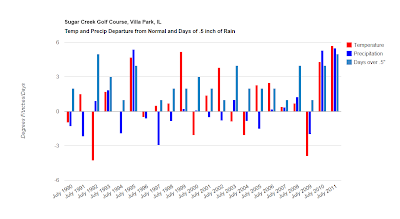A lot of golf course fairways have been hurting since it started raining this summer. I decided to go straight to the source and ask our fairways some tough questions. The following is a transcript of our interview:
So, fairway, it looks like you’ve been having a rough time in the past weeks?
Tell me about it! I was doing great up until it started raining again. I appreciate a nice shower. Even a short bath I can tolerate, but I can’t sit in water for a week. I can’t breathe. Especially when the sun is out – that water gets hot! Try holding your breath underwater in a hot tub. That’s what it’s been like.
How did you cope with the extreme heat? Was that a problem?
That string of really hot days wasn’t a walk in the park, but I survived.
The maintenance crew tried to give me just the right amount of water.
Too much water would have cooked me and too little would have permanently wilted me.
I made it through those hot days by breathing at night and holding my breath during mid-day.
That way I didn’t wilt to death during the middle of the day.
I’m not saying it was pleasant, but I can handle that for a while as long as the maintenance crew is helping me out.
If you didn’t mind the extreme heat, when did the trouble start?
Well.
I started getting wet.
The first downpour was alright.
I soaked it up and it was cloudy and not too hot out.
The second one on July 23
rd was way too much for me to handle, my roots were saturated and I couldn’t breathe.
Luckily it wasn’t too hot and sunny so you couldn’t really tell how much I was hurting.
It seemed like you suddenly got sick right after that. What happened next?
Just when I was starting to dry out and feel good again, I got a combined 2.5 inches of rain on the 28
th and 29
th.
Those two days were cloudy and not too hot so I just held on partially underwater.
Some of my low spots were starting to get smothered, but I was mostly ok.
And then it happened . . . Saturday and Sunday were the worst!
Did you get a horrible disease or something?
Not really.
The maintenance crew had just helped me out with some protectants that prevented most of the diseases.
I may have had a spot or two of Pythium Blight and Brown Patch, but that wasn’t really a big deal.
It was just the conditions out here on the 30
th and 31
st.
Remember, I’m plants, I can’t run away from lethal heat like you can -- hiding in your nice air conditioning all day and night!
I have to just sit here and take it.
I remember it was miserable out there in the middle of the day. Why couldn’t you use the water to cool off?
My roots were still soaked and it was very humid so I couldn’t transpire.
Kind of like humans and your sweat, I need to evaporate some water to cool myself off.
Didn't the maintenance crew just add some drain lines on the first hole to help you out?
Yes they did, and I appreciate the effort. They put a new line under the cart path and some other lines. I'm sorry, but the way I'm built, it's going to take a lot more than that to dry me out when it rains this much!
 |
| New drain and sodded area on #1. Sod didn't make it. |
OK. So what happened?
I wasn’t dry yet and the sun came out. July 30th was the sunniest day in a long time and the temperatures hit the low 90’s. The sun heated up the surface of the water that was partly covering my blades to over 110 degrees and it cooked their insides. In a four hour span on Saturday afternoon, a lot of my cells turned to useless soup. Sunday afternoon hurt again with the exact same conditions.
Can we do anything to help right now?
Well.
The maintenance crew tried to help by aerating some holes for me.
Unfortunately, it has continued to rain so I still haven’t been able to breathe much.
Just rained another 1.5 inches in the last 24 hours.
At least the temperatures have cooled off so I’m not losing any more plants.
I know the maintenance crew is going to aerate and overseed this week once I dry out a little.
I’ve been in this situation before and I always come back with a little help.
Please be patient while I grow some new shoots and roots.
Why are other areas of the course growing so well and you’re not?
There are lots of reasons, but most of them go back many years.
If you notice, I’m low and the greens and tees are high – for the most part.
They were built with soil and sand custom made for greens and tees.
I’m all clay, rock, asphalt, and brick.
You might not know this, but I was a rock dump before I was a golf course fairway.
The greens and tees got the benefit of topsoil and there wasn’t much left for me.
I have a rougher life than those pampered greens.
They don't even get driven on by carts! The tees are less spoiled – at least they have to deal with divots.
Now, if you'll excuse me, I need to grow some roots now.





